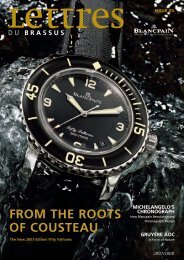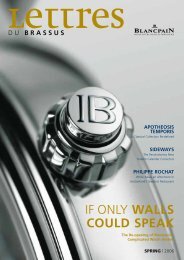THE HISTORY OF BLANCPAIN
THE HISTORY OF BLANCPAIN
THE HISTORY OF BLANCPAIN
Create successful ePaper yourself
Turn your PDF publications into a flip-book with our unique Google optimized e-Paper software.
ART DE VIVRE<br />
Champagne vineyards near Damery.<br />
to compose angry letters protesting this<br />
admittedly extreme observation, pause for a<br />
moment. Certainly most drinkers of champagne<br />
– leaving aside the gesticulating jocks<br />
shaking bottles and jiving around locker<br />
rooms after a World Cup or World Series<br />
(but then they aren’t drinking the stuff anyway,<br />
merely bathing in it) – know that the<br />
bottle may be a Moët & Chandon, Veuve<br />
Cliquot or perhaps even Taittinger Comte de<br />
Champagne. But those are just brand<br />
names. Even though you can correctly<br />
recount that it was favoured by Churchill,<br />
can you identify the particular grapes are<br />
used in a bottle of Pol Roger? Yes, it is a<br />
cuvée prestige, but from which vineyards<br />
does that Gosset Celebris, Grande Dame or<br />
Dom Perignon originate? Can you name the<br />
vineyards of Champagne and identify the<br />
grapes grown on each one? Can you devine<br />
the quality classification of each of those<br />
vineyards? Ah, perhaps that rush to fire off<br />
the irate letter might be slowed.<br />
Devotees of most wines can reel off this<br />
kind of detail. Burgundy fanatics happily<br />
debate whether a particular producer’s Clos<br />
de Vougeot (from a grand cru vineyard, of<br />
course and made of 100 % pinot noir)<br />
comes from the favoured upper slope near<br />
the Château or from the less-favoured rows<br />
adjacent to the Route Nationale. Similarly<br />
Bordeaux drinkers know the Châteaux 1855<br />
classifications (and the official 1973 amendment<br />
and the even the unofficial “Parker”<br />
amendments) and know the differences in<br />
grapes between the Médoc and the right<br />
bank. Napa Valley cab drinkers know what<br />
the Oakville bench is. And the same can be<br />
said for nearly all the other wine regions on<br />
earth. Details of grape and vineyard are at<br />
the forefront when wines are evaluated and<br />
choices are made. What is wrapped up in all<br />
of these details is the notion of terroir. A well<br />
made wine will reflect, better said, will be<br />
imbued, with the flavours and nuances of its<br />
exact place of origin and of course its<br />
cepage (grapes).<br />
So what is the exceptionalism that places<br />
champagnes on a different footing from<br />
essentially all the other prestige wines in the<br />
world, obscuring these details in the blazing<br />
glory of brand names? How is it that even<br />
the most rabid wine connoisseurs who revel<br />
in their encyclopedic grasp of all of the<br />
grape/vineyard pedigrees represented in<br />
their cellars, simply glide by the vitals when<br />
it comes to their bottles of bubbly?







